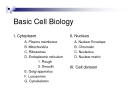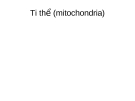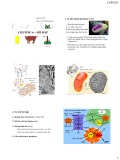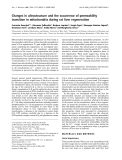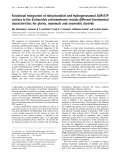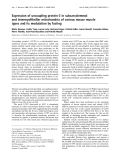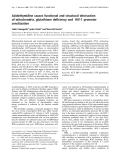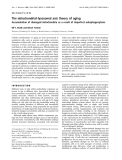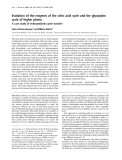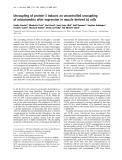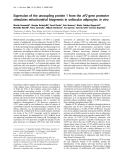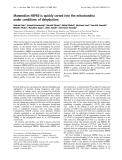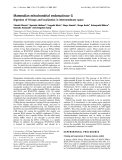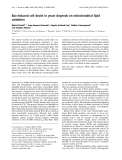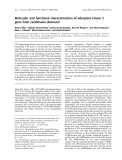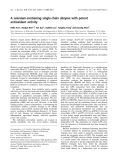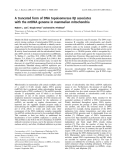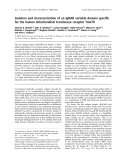
Mitochondria
-
Basic Cell Biology I. Cytoplasm A. Plasma membrane B. Mitochondria C. Ribosomes D. Endoplasmic reticulum 1. Rough 2. Smooth E. Golgi apparatus F. Lysosomes G. Cytoskeleton II. Nucleus A. Nuclear Envelope B. Chromatin C. Nucleolus D. Nuclear matrix III. Cell division .© 2002 by Bruce Alberts, Alexander Johnson, Julian Lewis, Martin Raff, Keith Roberts, and Peter Walter. .Asymmetrical arrangement of phospholipids in plasma membrane ATP-dependent phospholipid translocase .Molecular Cell Biology, Lodish et al., 4th edition. .Figure 2—1.
 68p
68p  whitedaisy1010
whitedaisy1010
 26-02-2013
26-02-2013
 63
63
 12
12
 Download
Download
-
Ti thể (tiếng Anh: mitochondrion (số nhiều: mitochondria)) là bào quan phổ biến ở các tế bào nhân chuẩn có lớp màng kép và hệ gene riêng. Ty thể được coi là trung tâm năng lượng của tế bào vì là nơi chuyển hóa các chất hữu cơ thành năng lượng tế bào có thể sử dụng được là ATP. Nguồn gốc của ty thể được coi như là một dạng vi khuẩn (xem thêm thuyết nội cộng sinh).
 54p
54p  shift_12
shift_12
 18-07-2013
18-07-2013
 270
270
 22
22
 Download
Download
-
Tham khảo bài thuyết trình 'ti thể (mitochondria)', tài liệu phổ thông, sinh học phục vụ nhu cầu học tập, nghiên cứu và làm việc hiệu quả
 22p
22p  ktouch_12
ktouch_12
 25-06-2013
25-06-2013
 73
73
 2
2
 Download
Download
-
Bài giảng Chương 6 "Hô hấp" cung cấp kiến thức cơ bản về Ty thể (mitochondria), cơ chế hô hấp, chu trình pentose phosphate, đường phân (Glycolysis), hô hấp yếm khí (lên men), chu trình Krebs (Chu trình Acid Citric),...
 8p
8p  convitdola
convitdola
 11-12-2017
11-12-2017
 88
88
 5
5
 Download
Download
-
Department of Medical Biochemistry and Biology, University of Bari, Italy; 2Department of Zoology, Laboratory of Histology and Comparative Anatomy, University of Bari, Italy; 3Center for the Study of Mitochondria and Energy Metabolism (CNR) Bari, Italy Mitochondrial bioenergetic impairment has been found in the organelles isolated from rat liver during the prereplicative phase of liver regeneration.
 9p
9p  system191
system191
 01-06-2013
01-06-2013
 37
37
 4
4
 Download
Download
-
The expression of mitochondrial and hydrogenosomal ADP/ATP carriers (AACs) from plants, rat and the anaerobic chytridiomycete fungus Neocallimastix spec. L2 in Escherichia coli allows a functional integration of the recombinant proteins into the bacterial cytoplasmic membrane. For AAC1 and AAC2 from rat, apparent Km values of about 40 lM for ADP, and 105 lM or 140 lM, respectively, for ATP have been determined, similar to the data reported for isolated rat mitochondria.
 10p
10p  system191
system191
 01-06-2013
01-06-2013
 39
39
 4
4
 Download
Download
-
Uncoupling protein-3 (UCP3) is a mitochondrial innermembrane protein abundantly expressed in rodent and human skeletal muscle which may be involved in energy dissipation. Many studies have been performed on the metabolic regulation of UCP3 mRNA level, but little is known about UCP3 expression at the protein level. Two populations of mitochondria have been described in skeletal muscle, subsarcolemmal (SS) and intermyofibrillar (IMF), which differ in their intracellular localization and possibly also their metabolic role....
 7p
7p  system191
system191
 01-06-2013
01-06-2013
 36
36
 4
4
 Download
Download
-
Mitochondrial functional and structural impairment and generation of oxidative stress have been implicated in aging, various diseases and chemotherapies. This study analyzed azidothymidine (AZT)-caused failures in mitochondrial functions, in redox regulation and activation of the HIV-1 gene expression. We monitored intracellular concentrations of ATP and glutathione (GSH) as the indicators of energy production and redox conditions, respectively, during the time-course experiments with U937 and MOLT4 human lymphoid cells in the presence of AZT (0.05 mgÆmL)1) or H2O2 (0.01 mM) for 15–25 days.
 7p
7p  system191
system191
 01-06-2013
01-06-2013
 46
46
 3
3
 Download
Download
-
Cellular manifestations of aging are most pronounced in postmitotic cells, such as neurons and cardiac myocytes. Alterations of these cells, which are responsible for essential functions of brain and heart, are particularly important contributors to the overall aging process. Mitochondria and lysosomes of postmitotic cells suffer the most remarkable age-related alterations of all cellular organelles.
 7p
7p  research12
research12
 01-06-2013
01-06-2013
 42
42
 5
5
 Download
Download
-
The citric acid or tricarboxylic acid cycle is a central element of higher-plant carbon metabolism which provides, among other things, electrons for oxidative phosphorylation in the inner mitochondrial membrane, intermediates for aminoacid biosynthesis, and oxaloacetate for gluconeogenesis from succinate derived from fatty acids via the glyoxylate cycle in glyoxysomes. The tricarboxylic acid cycle is a typical mitochondrial pathway and is widespread among a-proteobacteria, the group of eubacteria as de®ned under rRNA systematics from which mitochondria arose. ...
 16p
16p  research12
research12
 01-06-2013
01-06-2013
 47
47
 4
4
 Download
Download
-
The uncoupling proteins (UCPs) are thought to uncouple oxidative phosphorylation in the mitochondria and thus generate heat. One of the UCP isoforms, UCP3, is abun-dantly expressed in skeletal muscle, the major thermogenic tissue in humans. UCP3 has been overexpressed at high levels inyeast systems,where it leads to theuncouplingof cell respiration, suggesting that UCP3may indeed be capable of dissipating the mitochondrial proton gradient.
 9p
9p  research12
research12
 29-04-2013
29-04-2013
 40
40
 3
3
 Download
Download
-
Mitochondrial uncoupling protein 1 (UCP1) is a speci®c marker of multilocular brown adipocytes. Ectopic UCP1 in white fat of aP2-Ucp1micemitigates development of obesity byboth, increasing energy expenditure anddecreasingin situ lipogenesis. In order to further analyse consequences of respiratory uncoupling inwhite fat, the eects of the ectopic UCP1 on the morphology of adipocytes and biogenesis of mitochondria in these cells were studied.
 10p
10p  research12
research12
 29-04-2013
29-04-2013
 45
45
 4
4
 Download
Download
-
There are few reports concerning the sortingmechanisms of mammalian HSP60 into the mitochondria from the cyto-plasm. In the present study we investigated the protein import system. Based on immunoblotting and immuno-histochemistry, HSP60 was detected in both the cytoplasm andmitochondria. The purified cytoplasmicHSP60 showed chaperone activity, and the protein was imported into the mitochondriain vitro by a mitochondrial import assay.
 8p
8p  tumor12
tumor12
 22-04-2013
22-04-2013
 26
26
 1
1
 Download
Download
-
Mammalian mitochondria contain strong nuclease activity. Endonuclease G (endoG), which predominantly resides in mitochondria, accounts for a large part of this nuclease activity. It has been proposed to act as an RNase H-like nuclease on RNAÆDNA hybrids (R-loops) in the D-loop region where the origins of mitochondrial replication are mapped, providing RNA primers for mtDNA replication.
 6p
6p  tumor12
tumor12
 22-04-2013
22-04-2013
 38
38
 2
2
 Download
Download
-
The oxidant function of pro-apoptotic protein Bax was investigated through heterologous expression in yeast. Direct measurements of fatty acid content show that Bax-expression induces oxidation of mitochondrial lipids. This effect is prevented by the coexpression of Bcl-xL. The oxi-dation actually could be followed on isolated mitochondria as respiration-induced peroxidation of polyunsaturatedcis-parinaric acid and on whole cells as the increase in the amount of thiobarbituric acid-reactiveproducts. ...
 11p
11p  tumor12
tumor12
 22-04-2013
22-04-2013
 43
43
 2
2
 Download
Download
-
ATP-regenerating enzymes may have an important role in maintaining ATP levels in mitochondria-like kinetoplast organelle and glycosomes in parasitic protozoa. Adenylate kinase (AK) (ATP:AMP phosphotransferase) catalyses the reversible transfer of thec-phosphate group from ATP to AMP, releasing twomolecules ofADP. This study describes cloningand functional characterizationof the gene encoding AK2fromagenomic libraryofLeishmaniadonovaniandalso its expression in leishmania promastigote cultures.
 9p
9p  tumor12
tumor12
 20-04-2013
20-04-2013
 39
39
 3
3
 Download
Download
-
Reactive oxygen species (ROS) are products of normal metabolic activities and are thought to be the cause of many diseases. A selenium-containing single-chain abzyme 2F3 (Se-2F3-scFv) that imitates glutathione peroxidase has been produced which has the capacity to remove ROS. To evaluate the antioxidant ability of Se-2F3-scFv, we con-structeda ferrous sulfate/ascorbate (Vc/Fe 2+ )-inducedmito-chondrial damage model system and investigated the capacity of Se-2F3-scFv to protect mitochondria from oxi-dative damage.
 6p
6p  tumor12
tumor12
 20-04-2013
20-04-2013
 33
33
 4
4
 Download
Download
-
Despite the likely requirement for a DNA topoisomerase II activity during synthesis of mitochondrial DNA in mam-mals, this activity has been very difficult to identify convin-cingly.TheonlyDNAtopoisomerase II activity conclusively demonstrated to be mitochondrial in origin is that of a type II activity found associated with the mitochondrial, kineto-plast DNAnetwork in trypanosomatid protozoa [Melendy, T., Sheline, C., and Ray, D.S. (1988)Cell55, 1083–1088; Shapiro, T.A.,Klein,V.A., andEnglund, P.A. (1989)J.Biol. Chem.264, 4173–4178]....
 14p
14p  tumor12
tumor12
 20-04-2013
20-04-2013
 28
28
 3
3
 Download
Download
-
Exposure of mammalian cells to oxidant stress causes early (iron catalysed) lysosomal rupture followed by apoptosis or necrosis. Enhanced intracellular production of reactive oxygen species (ROS), presumably of mitochondrial origin, is also observed when cells are exposed to nonoxidant pro-apoptotic agonists of cell death. We hypothesized that ROS generation in this latter case might promote the apoptotic cascade and could arise from effects of released lysosomal materials on mitochondria.
 9p
9p  tumor12
tumor12
 20-04-2013
20-04-2013
 34
34
 1
1
 Download
Download
-
The new antigen receptor (IgNAR) from sharks is a disul-phide bonded dimer of two protein chains,each containing one variable and five constant domains,and functions as an antibody. In order to assess the antigen-binding capabilities of isolated IgNAR variable domains (VNAR),we have con-structed anin vitro library incorporating synthetic CDR3 regions of 15–18 residues in length.
 12p
12p  tumor12
tumor12
 20-04-2013
20-04-2013
 28
28
 3
3
 Download
Download
CHỦ ĐỀ BẠN MUỐN TÌM








